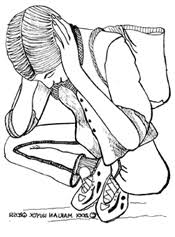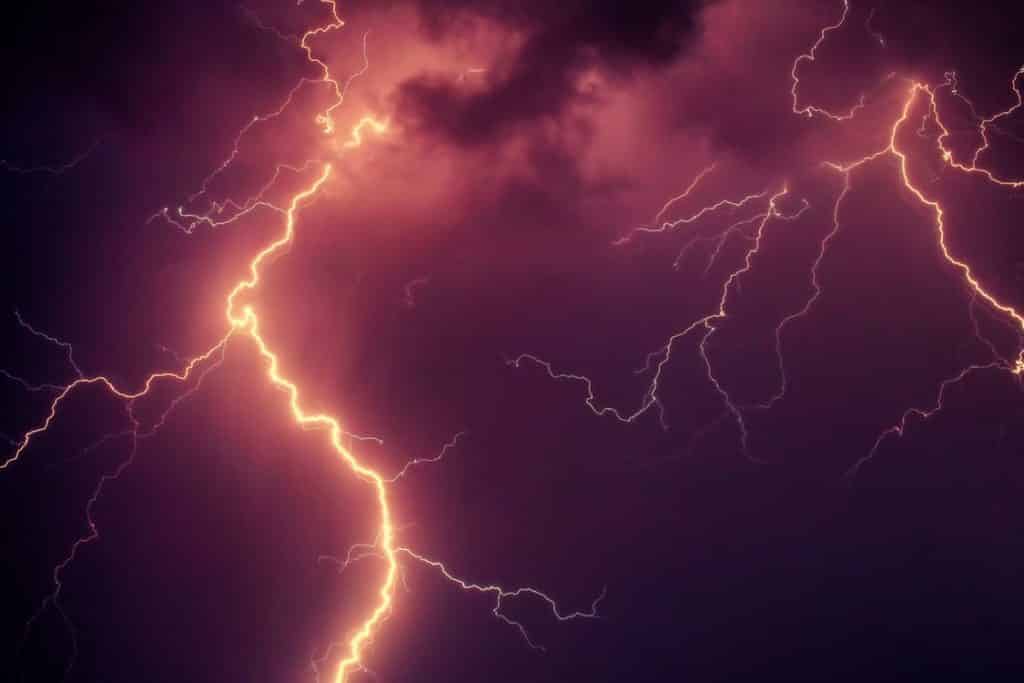When you go out into the wilderness you’re at the mercy of mother nature. It doesn’t matter how well you prepare if you hike long enough you’ll eventually get stuck out in a thunderstorm.
Don’t worry for every little curveball life throws at you there’s a simple solution. As long as you have a plan to deal with thunder and lightning it will be just another cool story to tell your friends.
Dealing With Thunder and Lightning During Your Hike
If you go out hiking long enough you’ll eventually have to deal with a little storm. You might be able to plan around the weather on short day hikes, but it’s hard to predict the weather on longer backpacking trips.
Throughout the years I’ve grown to love those quick storms that catch me by surprise. Seeing those far off bolts of lightning and roaring thunder is still an amazing site. Staying safe during a thunderstorm is all about knowing when you need to seek shelter.
Staying Dry
Staying dry shouldn’t be your top priority, but it sure helps relieve your sanity. Keeping dry is going to be especially important on extra long hikes.
When the weather forecast looks a little bit questionable I’m going to bring along my Frogg Toggs Rain Suit. It’s lightweight, but it tends to take up a lot of room in my hiking backpack.
On days where I’m not expecting rain I just toss one of these cheap disposable ponchos into my pack. They’re small enough to fit in your pocket and cheap enough to throw out after your done.
Lightning Safety During a Hike
With so many storms throughout the year you would think lightning would be a major danger to hikers. Actually there really aren’t that many people that get struck by lightning while hiking.
Considering about 50 people per year are killed by lightning in the United States it shouldn’t be high up your list of worries. Every year as people get more and more informed the death toll drops.
So How Do You Stay Safe During a Storm?
The key to staying safe during a lightning storm is staying alert and playing things safe. When you see horrible looking clouds out in the distance maybe you should start heading back to the car.
Your safety is your own responsibility out in the wilderness. Nobody is going to tell you to seek shelter.
When Should You Seek Shelter From The Storm?
It’s really going to be entirely up to you when you should seek shelter. Everybody has their own risk tolerances and willingness to roll the dice.
If I stayed home every time there was a chance of lightning I don’t think I’d ever get out.
- Before you go on your hike it’s important to check the weather reports. If there’s a high chance of storms maybe you should plan a shorter hike or at the very least pay some attention to your surroundings.
- Keep an eye on the sky checking for cloud formations. Take note of the direction the clouds are moving. If you notice a big storm approaching maybe head towards shelter.
- When the clouds start to look bad keep an eye out for lightning. Make sure you have your safety plan ready to go. By the time you start to hear thunder you better be close to shelter.
- Try to determine how far away the lightning is. Count how many seconds are between the thunder and lightning strikes. Closer strikes mean the lightning is hitting close by.
Remember the 30/30 Rule
You can figure out the distance of lightning by counting the seconds between a flash of lightning and thunder. Divide the total number of seconds by 5 to figure out the rough distance in miles.
If the strikes are less than 30 seconds away(6 miles) you are in the strike zone. You need to seek shelter immediately.
Mountain Storms are Normally Later in The Day
When hiking in mountainous terrain remember that most storms are in the evenings. Plan your hikes early in the morning and plan on getting off the mountain after lunch.
How Many Seconds to Hear Thunder?
Figure out how many seconds there are between the lightning and thunder strikes. Shorter time between strikes means the lightning is closer. Experts say that if the lightning is less than 30 seconds away you should seek shelter immediately.
When do you leave the shelter?
As a general rule wait at least 30 minutes to go back outside. It might be a bit overkill, but 30 minutes should guarantee the storm has fully passed.
How Do You Avoid Lightning Strikes in The Field?
During a lightning storm nowhere is completely safe. It doesn’t matter if you’re in a house, car, tent or under a big tree. You just need to minimize your chance of getting hit.
Minimizing your chances is all you can really do. If you can get to an enclosed building with electrical that’s where you want to go. Remember that gazebos and picnic shelters don’t offer any protection from lightning. It would be just as dangerous to stand under a tall tree.
Make a beeline for your car if you’re close to the trailhead. Otherwise follow these safety guidelines to protect yourself in a storm.
Lightning Safety Guidelines
You should only follow these guidelines if you are unable to seek shelter in your car or even better an enclosed building.
- Avoid Trees and Picnic Shelters: Never seek shelter inside a picnic shelter or under a tall tree. Most of these shelters aren’t going to be grounded so they basically act like a giant lightning rod. You’re better off standing out in the rain getting wet than standing under a tree.
- Leave High Ground: Higher ground is more likely to get struck than depressions. Lightning normally strikes the tallest object, so if you’re standing up on a hill that’s likely you. Take shelter in a valley or dip, but make sure there’s no chance of flooding.
- Put on Your Rain Gear: Make sure you have all your rain gear ready at the first sign of rain. Remove your backpack and place it somewhere that it will stay dry.
- Remove Metal Frame Backpacks: If you have a metal frame backpack make sure you take it off and place 50-100 ft away from you. Just like an umbrella the metal frame will attract lightning.
- Get Rid of Hiking Poles: Just like your backpack metal poles are going to attract lightning. Put your hiking stick and poles away with your backpack.
Do Seek Shelter
- In a cabin
- trail shelter
- Deep Inside a Cave
- Low Point
- Valley or Depression
Don’t Seek Shelter
- Under Trees
- Mountain Summit
- Under a Picnic Table
- Cave Entrance
- Avoid Peaks, High Points and Tall Objects
What if You Can’t Find Shelter?

If you are unable to find shelter get down as close to the ground as possible. Try to become the smallest target you possibly can. Crouch down in a ball and round your back. Minimize your contact with the ground by crouching on the balls of your feet.
- Crouch down like a baseball catcher.
- Get as low as you can. The closer you are to the ground the less likely you are to be struck. Remember to never lie down.
- Make sure you aren’t touching any conductors. Avoid your hiking poles, backpack, tent, umbrellas etc.
- The only thing touching the ground should be the balls of your feet. Lightning can enter your body through the ground so minimize contact.
- Place your hands over your hears to reduce hearing damage if you’re struck.
- If your hair starts to stand up or your skin starts to tingle you’re going to get hit. Crouch immediately and brace for impact.
Minimizing your footprint reduces your chance of getting struck by lightning. The rounded back further protects you by minimizing the damage to your vital organsCrouch down like a baseball
What if You’re Hiking in a Group?
If you’re hiking in a group try to get far away from each other. Each person should try to find shelter at least 100 feet away from each other. This is going to minimize the possibility of multiple injuries and ensure you have medical attention if struck.
Larger groups might want to pair off instead of spreading out solo. It’s going to be a dark, wet, cold and scary situation, so pairing up could reduce fear.
Lightning First Aid
Lightning should be treated like every other extreme electric shock. You will have to simultaneously treat both a burn and possibly stopped heart.
Make sure you keep track of everyone during the storm. If there is an especially close strike make sure everybody in your party is safe. If someone doesn’t respond they need immediate medical attention.
If the victim isn’t breathing they need immediate CPR. With CPR there’s a very good chance of reviving a lightning victim. Further check the victim for burns making sure you check around jewelry, belts, fingers and toes.

